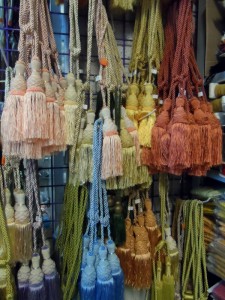In her book The Resolution for Women, Priscilla Shirer tells a story about a tassel. She was in the process of remodeling her writing office, and had not yet made basic decisions on color palette. Then a friend gave her a beautiful tassel. It was a gorgeous, multi-colored piece that came at a bargain price. Priscilla was tempted to keep it, until she realized the tassel would end up dictating all the décor decisions in her new office.
So, despite how much she loved that little tassel, she took it back.
Her point was that sometimes we allow a single detail—like a comment about our talents or character—to become a focal point in our lives, and then find ourselves changing our outlook or behaviors to match it.
Don’t let the wrong details define you. Or your characters.
What struck me as I read her warning was how often I fall into that trap when I am writing. It goes like this…
I am in the middle of a scene and the words are flowing. I run across the need for a bit of description. I grab the first idea that pops into my head and keep writing, trying to keep up with the muse before she gallops completely out of reach. Then, a scene or two later, I bump into that insignificant little detail, which now conflicts with some other detail, requires explanation, or forces the plot to go in a direction I hadn’t planned on.
Instead of thinking, huh, making him nearsighted adds complications I’d rather not deal with. What other unusual feature could I give him instead? I find myself going through all sorts of contortions to make his nearsightedness work.
Not exactly the most intentional of writing methods.
In fact, at my next critique session someone challenges a decision that I realize links back to that little detail, and I find myself forced to either defend a series of decisions that appear to lead the story astray or go back and fix the real problem—the random detail that created the mess.
It’s all about the [appropriate] details
When decorating a room, you sometimes select a single unique piece to become the focal point, but you want that focal point to be a lovely painting not the ugly chair you inherited from Great-aunt Bertha. Likewise, selecting just the right detail can set a character apart in a memorable way. For example, hobbits live in houses with round doors. Triangular doors or trapdoors would not be nearly as appropriate.
So remember to consider your details carefully. Ask why that detail is fitting, and if you’re not sure, take a moment to consider whether there might be a more apt choice.
The trick here is not to stifle your creativity, but to stop and analyze your thinking afterwards, to ensure all those pesky details are taking the story where you want it to go.
[bctt tweet=”Choose your tassels wisely. Details matter. #writetip”]
For more on the balance of rational and creative thoughts, check out this post from Kristen Lamb.






3 Comments
Thanks! I can see how this can apply to non-fiction writing as well.
Sometimes, in rewriting, I do change details and make the story much better. Sometimes, that detail turns out to be a blessing.
In both fiction and non-fiction there are so many things we could say, aren’t there? The hard part is choosing just the right details and letting go of the rest.